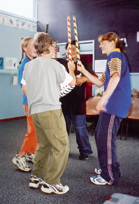|
|
:
Introduction |
|
The 2000 music assessments included five assessment tasks related to responding to music. All five tasks were identical for year 4 and year 8 students. One is a trend task (fully described with data for both 1996 and 2000), two are released tasks (fully described with data for 2000 only), and two are link tasks (to be used again in 2004, so only partially described here). The task details and results for the trend task are presented in the first section, followed by the task details and results for the two released tasks. The third section contains some task information and the results for the two link tasks. Comparing
results for year 4 and year 8 students Trend
results: comparing 1996 and 2000 results For year 4 students, modest improvement was evident. Looking first at the most positive rating category for each component, there was improvement from 1996 to 2000 on four of the five components, with on average two percent more students gaining the highest rating (a very slight change). Looking at the lowest rating category for each component, greater improvement was evident, with the percentages dropping on all five components. On average 10 percent fewer students gained the lowest rating. For
year 8 students there was quite substantial improvement between 1996
and 2000. Looking first at the most positive rating category for each
component, there were increases from 1996 to 2000 on all five components,
with on average eight percent more students gaining the highest rating.
Looking at the lowest rating category for each component, similar improvement
was evident, with the percentages dropping on all five components and
on average 12 percent fewer students gaining the lowest rating. |
|||||
